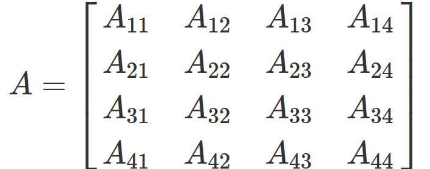The determinant of a 4x4 matrix is a special number that you find using a specific formula. A matrix with n rows and n columns is called a square matrix. So, a 4x4 matrix is a square matrix with four rows and four columns. If we have a square matrix A, the determinant of A is...

represedted as A.
Determinant
A determinant is a number linked to a square matrix (a matrix with the same number of rows and columns) in math. It gives us important information about the matrix, like whether it can be inverted or if it has special properties.
To find the determinant, you use different methods based on the matrix size. For small matrices like 2x2 and 3x3, you can calculate it directly. For bigger ones, like 4x4 or larger, you might use the Laplace formula or other advanced methods.
In simple words, the determinant is like a "summary" of a square matrix that tells us useful things about it and how it relates to the surrounding space.
Symbol of Determinant
The determinant of a matrix is shown using "det" or the matrix's name with bars around it, like \( \det(A) \) or \( |A| \). Sometimes, it's also shown with a script "d", like \( dA \).
What is a Matrix?
A matrix is a grid of numbers arranged in rows and columns. The elements in a matrix can be single numbers, rows, columns, or even other matrices. Matrices are used in math and computer science for many purposes, like solving systems of linear equations, showing transformations and rotations in graphics and physics, and organizing data in a neat way.
Formula to Find Determinant of a 4x4 Matrix
To find the determinant of a 4x4 matrix, you can use this formula:
det(A) = a11 * det(A11) - a12 * det(A12) + a13 * det(A13) - a14 * det(A14)
Here’s what the terms mean:
aijis the element in the ith row and jth column of the matrix A.Aijis the smaller matrix you get by removing the ith row and jth column from A.
This formula, called the Laplace formula, breaks down the 4x4 matrix into smaller parts until you get to 2x2 matrices, where the determinant can be calculated directly.
How to Calculate the Determinant of a 4x4 Matrix
To find the determinant of a 4x4 matrix, use the Laplace formula. Here’s an example matrix A:
| a11 a12 a13 a14 |
| a21 a22 a23 a24 |
| a31 a32 a33 a34 |
| a41 a42 a43 a44 |
The determinant of A is:
det(A) = a11 * det(A11) - a12 * det(A12) + a13 * det(A13) - a14 * det(A14)
You keep breaking down the matrices until you get to 2x2 matrices, where you can find the determinant easily.
This is one way to find the determinant of a 4x4 matrix. There are other methods, depending on what you need for your problem.
Frequently Asked Questions
To find the determinant of a 4x4 matrix, we can use the regular method. Start with the first element in the first row, multiply it by the determinant of the smaller 3x3 matrix that remains after removing the row and column of that element, and repeat this process for the other elements.
The determinant of a 4×4 matrix is a specific number found using a certain formula. When a matrix has the form n x n, it is called a square matrix. Thus, a 4×4 matrix is a square matrix with four rows and four columns. If we have a square matrix A, we show its determinant as |A|.
To find the minor of an element in a matrix, like aija_{ij}aij in matrix A, follow these steps:
- Remove the row and column that contain aija_{ij}aij.
- Calculate the determinant of the smaller matrix that is left.
Repeat this process for each element in the matrix to find all the minors.
The determinant is found with this formula: |A| = a(ei - fh) - b(di - fg) + c(dh - eg). In simple terms, this means you do 'a times (e times i minus f times h) minus b times (d times i minus f times g) plus c times (d times h minus e times g)'. It might seem tricky, but if you look closely at the pattern, it's actually easy!